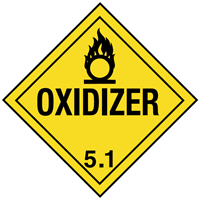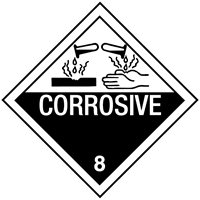
 Print
Print
Chemical Datasheet
HYDROGEN PEROXIDE, AQUEOUS SOLUTION, WITH NOT LESS THAN 20% BUT NOT MORE THAN 60% HYDROGEN PEROXIDE (STABILIZED AS NECESSARY) |


|
Chemical Identifiers
| CAS Number |
UN/NA Number |
DOT Hazard Label |
USCG CHRIS Code |
- 7722-84-1

|
|
|
none
|
| NIOSH Pocket Guide |
International Chem Safety Card |
|
Hydrogen peroxide
|
- HYDROGEN PEROXIDE (>60% SOLUTION IN WATER)
|
NFPA 704
General Description
Colorless aqueous solution. Vapors may irritate the eyes and mucous membranes. Contact with most common metals and their compounds may cause violent decomposition, especially in the higher concentrations. Contact with combustible materials may result in spontaneous ignition. Prolonged exposure to fire or heat may cause decomposition and rupturing of the container. Used to bleach textiles and wood pulp, in chemical manufacturing and food processing.
Hazards
Reactivity Alerts
- Explosive
- Strong Oxidizing Agent
Air & Water Reactions
An aqueous solution that is readily diluted.
Fire Hazard
Excerpt from ERG Guide 140 [Oxidizers]:
CAUTION: Ammonium nitrate products may explode if involved in fire or contaminated with hydrocarbons (fuels), organic matter, other contaminants or when hot molten and contained. Treat as an explosive (ERG Guide 112). These substances will accelerate burning when involved in a fire. Some may decompose explosively when heated or involved in a fire. May explode from heat or contamination. Some will react explosively with hydrocarbons (fuels). May ignite combustibles (wood, paper, oil, clothing, etc.). Containers may explode when heated. Runoff may create fire or explosion hazard. (ERG, 2024)
Health Hazard
Excerpt from ERG Guide 140 [Oxidizers]:
Inhalation, ingestion or contact (skin, eyes) with vapors or substance may cause severe injury, burns or death. Fire may produce irritating, corrosive and/or toxic gases. Runoff from fire control or dilution water may cause environmental contamination. (ERG, 2024)
Reactivity Profile
The hazards associated with the use of HYDROGEN PEROXIDE (especially highly concentrated solutions) are well documented. There is a release of enough energy during the catalytic decomposition of 65% peroxide to evaporate all water and ignite nearby combustible materials. Most cellulose materials contain enough catalyst to cause spontaneous ignition with 90% peroxide. Contamination of concentrated peroxide causes the possibility of explosion. Readily oxidizable materials, or alkaline substances containing heavy metals may react violently. Solvents(acetone, ethanol, glycerol) will detonate on mixture with peroxide of over 30% concentration, the violence increasing with concentration. Concentrated peroxide may decompose violently in contact with iron, copper, chromium, and most other metals or their salts, and dust(which frequently contain rust). During concentration under vacuum of aqueous or of aqueous-alcoholic solutions of hydrogen peroxide, violent explosions occurred when the concentration was sufficiently high(>90%), [Bretherick 2nd ed., 1979]. Mixtures of alcohols with concentrated sulfuric acid and strong hydrogen peroxide can cause explosions. Example: An explosion will occur if dimethylbenzylcarbinol is added to 90% hydrogen peroxide then acidified with concentrated sulfuric acid. Mixtures of ethyl alcohol with concentrated hydrogen peroxide form powerful explosives. Mixtures of hydrogen peroxide and 1-phenyl-2-methyl propyl alcohol tend to explode if acidified with 70% sulfuric acid, [Chem. Eng. News 45(43):73(1967); J, Org. Chem. 28:1893(1963)]. Hydrogen selenide and hydrogen peroxide undergo a very rapid decomposition, [Mellor 1:941(1946-1947)].
Belongs to the Following Reactive Group(s)
- Oxidizing Agents, Strong
- Water and Aqueous Solutions
Potentially Incompatible Absorbents
Use caution: Liquids with this reactive group classification have been
known to react with the
absorbents
listed below.
- Cellulose-Based Absorbents
- Expanded Polymeric Absorbents
Response Recommendations
Isolation and Evacuation
Excerpt from ERG Guide 140 [Oxidizers]:
IMMEDIATE PRECAUTIONARY MEASURE: Isolate spill or leak area in all directions for at least 50 meters (150 feet) for liquids and at least 25 meters (75 feet) for solids.
LARGE SPILL: Consider initial downwind evacuation for at least 100 meters (330 feet).
FIRE: If tank, rail tank car or highway tank is involved in a fire, ISOLATE for 800 meters (1/2 mile) in all directions; also, consider initial evacuation for 800 meters (1/2 mile) in all directions. If ammonium nitrate products are in a tank, rail car or truck and involved in a fire, ISOLATE for 1600 meters (1 mile) in all directions; also, initiate evacuation including emergency responders for 1600 meters (1 mile) in all directions. (ERG, 2024)
Firefighting
Excerpt from ERG Guide 140 [Oxidizers]:
SMALL FIRE: Use water. Do not use dry chemicals or foams. CO2 or Halon® may provide limited control.
LARGE FIRE: Flood fire area with water from a distance. Do not move cargo or vehicle if cargo has been exposed to heat. If it can be done safely, move undamaged containers away from the area around the fire.
FIRE INVOLVING TANKS, RAIL TANK CARS OR HIGHWAY TANKS: For ammonium nitrate products: Do not fight cargo fire. Withdraw, evacuate and isolate area for at least 1600 meters (1 mile). Treat as an explosive (ERG Guide 112). Do not enter area for 24 hours or until expert advice has been provided. Fight fire from maximum distance or use unmanned master stream devices or monitor nozzles. Cool containers with flooding quantities of water until well after fire is out. ALWAYS stay away from tanks in direct contact with flames. For massive fire, use unmanned master stream devices or monitor nozzles; if this is impossible, withdraw from area and let fire burn. (ERG, 2024)
Non-Fire Response
Excerpt from ERG Guide 140 [Oxidizers]:
Keep combustibles (wood, paper, oil, etc.) away from spilled material. Do not touch damaged containers or spilled material unless wearing appropriate protective clothing. Stop leak if you can do it without risk. Do not get water inside containers.
SMALL DRY SPILL: With clean shovel, place material into clean, dry container and cover loosely; move containers from spill area.
SMALL LIQUID SPILL: Use a non-combustible material like vermiculite or sand to soak up the product and place into a container for later disposal.
LARGE SPILL: Dike far ahead of liquid spill for later disposal. (ERG, 2024)
Protective Clothing
Excerpt from ERG Guide 140 [Oxidizers]:
Wear positive pressure self-contained breathing apparatus (SCBA). Wear chemical protective clothing that is specifically recommended by the manufacturer when there is NO RISK OF FIRE. Structural firefighters' protective clothing provides thermal protection but only limited chemical protection. (ERG, 2024)
DuPont Tychem® Suit Fabrics
Normalized Breakthrough Times (in Minutes)
| Chemical |
CAS Number |
State |
QS |
QC |
SL |
C3 |
TF |
TP |
RC |
TK |
RF |
| Hydrogen peroxide (30%) |
7722-84-1 |
Liquid |
|
>480 |
>480 |
|
|
|
>480 |
>480 |
|
| Hydrogen peroxide (50%) |
7722-84-1 |
Liquid |
|
>480 |
|
>480 |
>480 |
>480 |
|
|
|
| Hydrogen peroxide (70%) |
7722-84-1 |
Liquid |
>480 |
>480 |
|
|
>480 |
>480 |
>480 |
>480 |
>480 |
Special Warning from DuPont: Tychem® and Tyvek® fabrics should not be
used around heat, flames, sparks or in potentially flammable or
explosive environments. Only...
(DuPont, 2024)
First Aid
EYES: First check the victim for contact lenses and remove if present. Flush victim's eyes with water or normal saline solution for 20 to 30 minutes while simultaneously calling a hospital or poison control center. Do not put any ointments, oils, or medication in the victim's eyes without specific instructions from a physician. IMMEDIATELY transport the victim after flushing eyes to a hospital even if no symptoms (such as redness or irritation) develop.
SKIN: IMMEDIATELY flood affected skin with water while removing and isolating all contaminated clothing. Gently wash all affected skin areas thoroughly with soap and water. IMMEDIATELY call a hospital or poison control center even if no symptoms (such as redness or irritation) develop. IMMEDIATELY transport the victim to a hospital for treatment after washing the affected areas.
INHALATION: IMMEDIATELY leave the contaminated area; take deep breaths of fresh air. If symptoms (such as wheezing, coughing, shortness of breath, or burning in the mouth, throat, or chest) develop, call a physician and be prepared to transport the victim to a hospital. Provide proper respiratory protection to rescuers entering an unknown atmosphere. Whenever possible, Self-Contained Breathing Apparatus (SCBA) should be used; if not available, use a level of protection greater than or equal to that advised under Protective Clothing.
INGESTION: DO NOT INDUCE VOMITING. Corrosive chemicals will destroy the membranes of the mouth, throat, and esophagus and, in addition, have a high risk of being aspirated into the victim's lungs during vomiting which increases the medical problems. If the victim is conscious and not convulsing, give 1 or 2 glasses of water to dilute the chemical and IMMEDIATELY call a hospital or poison control center. IMMEDIATELY transport the victim to a hospital. If the victim is convulsing or unconscious, do not give anything by mouth, ensure that the victim's airway is open and lay the victim on his/her side with the head lower than the body. DO NOT INDUCE VOMITING. Transport the victim IMMEDIATELY to a hospital. (NTP, 1992)
Physical Properties
Flash Point: data unavailable
Lower Explosive Limit (LEL): data unavailable
Upper Explosive Limit (UEL): data unavailable
Autoignition Temperature: data unavailable
Melting Point:
31.3°F
(NTP, 1992)
Vapor Pressure:
1 mmHg
at 59.5°F
(NTP, 1992)
Vapor Density (Relative to Air): data unavailable
Specific Gravity:
1.11
at 68°F
(NTP, 1992)
- Denser than water; will sink
Boiling Point:
302.4°F
at 760 mmHg
(NTP, 1992)
Molecular Weight:
34.02
(NTP, 1992)
Water Solubility:
greater than or equal to 100 mg/mL
at 72°F
(NTP, 1992)
Ionization Energy/Potential:
10.54 eV
[From NPG: Hydrogen peroxide]
(NIOSH, 2024)
IDLH:
75 ppm
[From NPG: Hydrogen peroxide]
(NIOSH, 2024)
AEGLs (Acute Exposure Guideline Levels)
No AEGL information available.
ERPGs (Emergency Response Planning Guidelines)
| Chemical |
ERPG-1 |
ERPG-2 |
ERPG-3 |
| Hydrogen Peroxide (7722-84-1)
|
10 ppm |
50 ppm |
100 ppm |
(AIHA, 2022)
PACs (Protective Action Criteria)
| Chemical |
PAC-1 |
PAC-2 |
PAC-3 |
| Hydrogen peroxide (7722-84-1)
|
10 ppm |
50 ppm |
100 ppm |
(DOE, 2024)
Regulatory Information
EPA Consolidated List of Lists
| Regulatory Name |
CAS Number/
313 Category Code |
EPCRA 302
EHS TPQ |
EPCRA 304
EHS RQ |
CERCLA RQ |
EPCRA 313
TRI |
RCRA
Code |
CAA 112(r)
RMP TQ |
| Hydrogen peroxide (Conc.> 52%) |
7722-84-1 |
1000 pounds |
1000 pounds |
|
|
|
|
(EPA List of Lists, 2024)
CISA Chemical Facility Anti-Terrorism Standards (CFATS)
|
RELEASE |
THEFT |
SABOTAGE |
| Chemical of Interest |
CAS Number |
Min Conc |
STQ |
Security
Issue |
Min Conc |
STQ |
Security
Issue |
Min Conc |
STQ |
Security
Issue |
| Hydrogen peroxide (concentration of at least 35%) |
7722-84-1 |
|
|
|
35.00 % |
400 pounds |
EXP/IEDP |
|
|
|
(CISA, 2007)
OSHA Process Safety Management (PSM) Standard List
| Chemical Name |
CAS Number |
Threshold Quantity (TQ) |
| Hydrogen Peroxide (52% by weight or greater) |
7722-84-1 |
7500 pounds |
(OSHA, 2019)
Alternate Chemical Names
- ALBONE
- ALBONE 35
- ALBONE DS
- BAQUASHOCK
- DIHYDROGEN DIOXIDE
- HIPOX
- HYBRITE
- HYDROGEN DIOXIDE
- HYDROGEN PEROXIDE
- HYDROGEN PEROXIDE (35% TO 52% BY WEIGHT)
- HYDROGEN PEROXIDE (CONC.> 52%)
- HYDROGEN PEROXIDE SOLUTION (30%)
- HYDROGEN PEROXIDE SOLUTION, [40% TO 52% PEROXIDE]
- HYDROGEN PEROXIDE, AQUEOUS SOLUTION, WITH NOT LESS THAN 20% BUT NOT MORE THAN 60% HYDROGEN PEROXIDE (STABILIZED AS NECESSARY)
- HYDROPEROXIDE
- INHIBINE
- METROKUR
- ODOSAT D
- OXYDOL
- OXYFULL
- OXYSEPT I
- PERHYDROL
- PERONE
- PEROXAAN
- PEROXIDE
- SELECT BLEACH
- SUPEROXOL
- T-STUFF



 Print
Print

